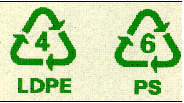Bureau Home / Consumer Tips and Information / Advertising and Marketing / Environmental Advertising
This content is also available as a downloadable
fact sheet PDF.
Acceda a esta página en español.
Many consumers look for products that produce little waste or are not harmful to the environment. Manufacturers and retailers have tried to meet this demand by improving and promoting the environmental qualities of their products. Products are often advertised as “recyclable,” “recycled,” or “degradable.”
Unfortunately, it is not always clear what these claims mean. Everyone has heard claims that are exaggerated, misleading, or simply false. Deceptive claims cast doubt on all environmental advertising and hurt companies making legitimate claims.
The law
Wisconsin’s environmental labeling law helps you get clear and reliable information. The law also protects honest companies from competitors who make deceptive environmental claims.
Claims must be clearly stated and explained well enough that you will not be misled or confused.
Claims must be backed up by reliable evidence. Upon written request, evidence to support the claim must be provided to the Wisconsin Department of Agriculture, Trade, and Consumer Protection.
Claims that a product is recycled, recyclable, or degradable must be valid in all areas where the product is sold or must include a clear explanation of where the claim is valid.
Green marketing claims
Green. Environmentally safe. Eco friendly. Claims like these may sound great, but they are too vague to be meaningful. The fact is, all products have some environmental impact.
“Free Of” — Companies may make a point of telling you their products are “free of” a chemical or ingredient that may be a concern. When marketers say a product is “free of” an ingredient, they should be able to prove that the product does not have any more than a harmless trace amount of it – and that the product is free of any other ingredient that poses the same kind of risk.
“VOC Free” — For example, you may have seen products labeled “low-VOC” or “VOC-free”. VOCs – or volatile organic compounds – are found in products including paint, household cleaners, floor polishes, charcoal lighter fluid, windshield wiper fluid and some hair styling products. They are emitted as gases, and may cause smog by contributing to ground-level ozone formation, or have negative effects on your health.
“Non-Toxic” — Marketers who say a product is “non-toxic” should have proof that the product is safe for both humans and the environment. If it is safe for humans or the environment, the product should say which one the claim applies to or both.
“Ozone-Friendly” — All ozone is not alike. The ozone layer in the upper atmosphere prevents harmful radiation from the sun from reaching the earth. But ozone at ground level forms smog and can cause serious breathing problems for some people. If a company claims its products are “ozone-friendly” or “ozone safe,” it should have proof that the products do not harm the upper ozone layer and the air at ground level.
“Less Waste” — A marketer should do more than claim its product or package is made with “less waste,” it should give specifics about the comparison. For example, a company could say a product has 10 percent less waste than a previous product.
Recyclable
Recyclability depends on what your community can actually recycle. Plastic milk jugs and soda bottles, for example, are recyclable in most communities. But many other kinds of plastic and plastic containers may not be recyclable. Recyclability claims must be clear about how and where the products are recyclable.
Symbol meanings -  These symbols tell what kind of material is used to make a container. They do not mean the container is recyclable in your community.
These symbols tell what kind of material is used to make a container. They do not mean the container is recyclable in your community.
Local recycling - Product labels can be a good source of waste management information. Contact your local recycling agency to find out what can be recycled in your community and how.
Biodegradable
Marketers often claim their product is “degradable” or “biodegradable,” but if a product is headed for a landfill (where most trash ends up), a company should not make this claim without explaining how long the product will take to degrade and how much it will break down over time.
Something that is biodegradable, like food or leaves, breaks down and decomposes into elements found in nature when it is exposed to light, air, moisture, certain bacteria, or other organisms. But most trash ends up in landfills which are designed to shut out sunlight, air and moisture. That keeps pollutants out of the air and drinking water, but also slows decomposition. Things, like food, that usually decompose quickly, could take decades (or longer) to decompose in a landfill.
If a company says its product is “degradable,” and the product is typically thrown out in the trash, the company should have proof that the product will completely break down and return to nature in a landfill in the time or at the rate the ad states.
Recycled material
Claims that a product is made of recycled material must state the minimum percentage of recycled material in the product. For example, if a product states “made of 35% recycled material,” at least 35% of the product must contain recycled material.
Watch out for:
Overly broad or vague claims. Claims that a product is “environmentally friendly” or “eco-safe” are so broad that they are virtually meaningless.
Claims that are not adequately explained. A claim should tell you enough to know whether it is valid in your community.
Exaggerated claims. Some claims may be true, but the benefits are small or irrelevant.
Jargon. Do not accept a claim just because it uses complicated technical terms and seems to be over your head.